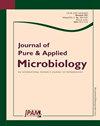阿尔及利亚中北部伤口感染者脓液/伤口样本的细菌学特征和抗生素耐药模式
IF 0.6
Q4 MICROBIOLOGY
引用次数: 0
摘要
本研究于2016年至2020年在阿尔及利亚中北部艾因德法区的Makour Hamou公立医院进行。该研究旨在描述从620例化脓性皮肤伤口患者中分离的细菌的抗菌素耐药性和多药耐药性。428株分离菌中革兰氏阳性283株(66.12±4.48%)(P<0.001)。共分离出77株金黄色葡萄球菌,其中耐甲氧西林的占31.2±9.3%(24/77)。革兰氏阴性菌最多的是大肠杆菌(30.34±7.4%),其次是肺炎克雷伯菌(25.52±7.10%)和铜绿假单胞菌(23.45±6.70%)。所有金黄色葡萄球菌(77/77)对克林霉素敏感。大肠杆菌分离株对几种抗生素耐药,对阿莫西林耐药率较高(38/44;86.4±10.1%),阿莫西林-克拉维酸酯(30/44;68.2±13.8%),头孢唑林(21/44;47.7±7.5%)和甲氧苄啶-磺胺甲恶唑(16/44;36.4±14.2%)(P<0.001)。所有革兰氏阴性菌均对阿米卡星敏感(145/145),仅有1株革兰氏阳性菌(99.65±0.69%)对万古霉素耐药。31.54%的分离株存在多药耐药;与革兰氏阳性菌相比,革兰氏阴性菌显著高于革兰氏阳性菌(62/145;42.76±8%和73/283;分别为25.79±5.10%)(P<0.001)。多药耐药率与患者年龄显著相关(P<0.001),但与年龄无关。这些结果表明存在不同种类的细菌从人类伤口感染。对一种或多种抗生素耐药较为常见。建议减少抗生素的不合理使用,并在任何抗生素处方前更频繁地使用抗生素谱。本文章由计算机程序翻译,如有差异,请以英文原文为准。
Bacteriological Profile and Antibiotic Resistance Patterns of Pus/Wound Samples in Humans with Infected Wounds in North Central Algeria
The present study was carried out between 2016 and 2020 in Makour Hamou Public Hospital, Ain Defla district, North Centre of Algeria. The study aimed to characterise the antimicrobial resistance and multidrug resistance in bacteria isolated from 620 patients with purulent skin wounds. Out of the 428 bacterial isolates, 283 were Gram-positive (66.12 ± 4.48%) (P<0.001). A total number of 77 Staphylococcus aureus isolates were obtained, among them 31.2 ± 9.3% (24/77) were methicillin-resistant. The most frequent Gram-negative bacteria were Escherichia coli (30.34±7.4%), followed by Klebsiella pneumoniae (25.52±7.10%), and Pseudomonas aeruginosa (23.45±6.70%). All Staphylococcus aureus isolates (77/77) were sensitive to clindamycin. Escherichia coli isolates were resistant to several antibiotics with high resistance rates to amoxicillin (38/44; 86.4 ± 10.1%), amoxicillin-clavulanate (30/44; 68.2 ± 13.8%), cefazolin (21/44; 47.7 ± 7.5%) and trimethoprim-sulfamethoxazole (16/44; 36.4 ± 14.2%) (P<0.001). All Gram-negative bacteria were sensitive to amikacin (145/145) and only one Gram-positive isolate (99.65 ± 0.69%) was resistant to vancomycin. Multidrug resistance was observed in 31.54% of isolates; it was significantly higher in Gram-negative compared to Gram-positive bacteria (62/145; 42.76 ± 8% and 73/283; 25.79 ± 5.10%, respectively) (P<0.001). Multidrug resistance rate was significantly correlated to patients’ age (P<0.001) but not according to years. These results showed the presence of different bacteria species from human wound infections. The resistance to one or multiple antibiotics were frequent. It is recommended to reduce irrational use of antibiotics and a more frequent use of antibiogram before any antibiotic prescription.
求助全文
通过发布文献求助,成功后即可免费获取论文全文。
去求助
来源期刊

Journal of Pure and Applied Microbiology
BIOTECHNOLOGY & APPLIED MICROBIOLOGY-MICROBIOLOGY
CiteScore
2.00
自引率
0.00%
发文量
266
审稿时长
11 months
期刊介绍:
Journal of Pure and Applied Microbiology (JPAM) is a peer-reviewed, open access international journal of microbiology aims to advance and disseminate research among scientists, academics, clinicians and microbiologists around the world. JPAM publishes high-quality research in all aspects of microbiology in both online and print form on quarterly basis.
 求助内容:
求助内容: 应助结果提醒方式:
应助结果提醒方式:


